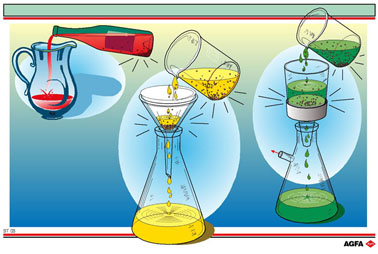ST03
Separation of heterogeneous solid - liquid mixtures
| Aim:
To illustrate a number of simple ways of separating heterogeneous
solid - liquid mixtures. |
The middle and right hand side of illustration ST 03 show filtration being used as the most efficient method for separating a heterogeneous solid - liquid mixture. In this method the size of the pores in the filter needs to be adjusted according to the size of the particles to be filtered out of the mixture. The mixture is separated into a filtrate that runs through the filter (the liquid phase) and a residue that remains on the filter (the solid phase).
Sucking
away the air from under the filter can speed up the filtration process.
A vacuum forms under the filter causing a pressure difference to build
up, so that the liquid phase is pushed through the filter by the excess
atmospheric pressure above it (right hand figure). A good example of this
is the filtration of seawater to remove the sand and sediment before desalination.
A less efficient but nevertheless frequently used technique for liquid-solid
separation, namely decanting, is illustrated on the left of the illustration.
Decanting can be used with wine to separate out the sediment; the wine
is decanted from the bottle into a carafe leaving the sediment behind
in the bottle.
